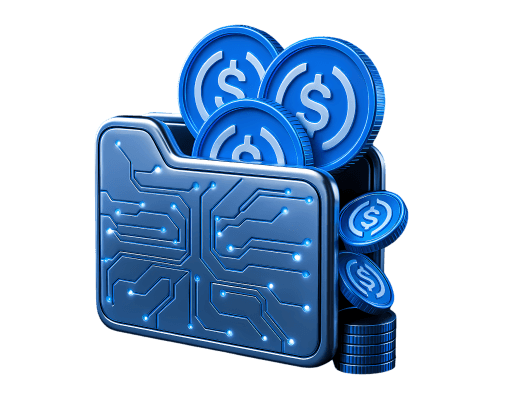Your Ultimate Guide to the Best USDC Wallets

Why Your USDC Deserves a First-Class Wallet
In the rapidly evolving world of digital finance, USD Coin (USDC) has established itself as a cornerstone of stability and reliability. As an asset-backed, fiat-pegged stablecoin, each USDC is designed to be redeemable 1:1 for U.S. dollars, offering a dependable digital asset for UK users seeking to avoid the volatility of other cryptocurrencies. Governed by the Centre Consortium, co-founded by Circle, USDC operates on multiple blockchains as a token, most famously as an ERC-20 token on the Ethereum network.
Its use cases are vast and growing, from providing a stable medium for trading and decentralised finance (DeFi) protocols to facilitating low-cost cross-border payments and offering a safe haven for digital savings. But to truly harness the power of USDC, one component is non-negotiable: a dedicated, secure wallet. Choosing the right USDC wallet is not merely a matter of convenience; it is the fundamental step in protecting your assets, ensuring you have full control, and unlocking the coin's full potential. This guide will help you select the best wallet for your needs.
The UK's Top 15 USDC Wallets: A Comprehensive Review
Selecting the ideal home for your USD Coin involves balancing security, accessibility, and features. Here, we analyse the top 15 wallets available to UK users, categorised for clarity.
Hardware Wallets: The Gold Standard for Security
For ultimate security, nothing surpasses a hardware wallet. These physical devices keep your private keys offline, immune to online threats.
- Ledger Nano X: A premium hardware wallet offering Bluetooth connectivity for mobile management. It provides top-tier security for your USDC and a vast range of other assets, making it perfect for serious investors.
- Ledger Nano S Plus: Offers the same robust security as the Nano X but without Bluetooth, making it a more affordable yet equally secure option. It features a larger screen than its predecessor for easier transaction verification.
- Trezor: A pioneer in hardware wallets, Trezor models are renowned for their security and open-source principles. While Trezor's native software has limitations, it integrates seamlessly with third-party wallets like MetaMask to manage USDC securely.
- SafePal S1: A credit-card-sized hardware wallet that uses a completely offline, air-gapped signing mechanism with a scannable QR code for transactions, offering a unique blend of security and mobile-friendliness.
Mobile & Desktop Wallets: Convenience Meets Control
Software wallets offer a fantastic balance of robust security and everyday usability, perfect for active users.
- Trust Wallet: A highly popular, multi-chain mobile wallet that supports a vast array of tokens, including USDC on various networks. Its clean interface makes it easy to send and receive USDC, and it features an in-built dApp browser.
- Coinbase Wallet: A non-custodial wallet from the trusted Coinbase brand, separate from its exchange. It provides a secure way to store your USD Coin and explore the decentralised web with ease.
- Exodus: A visually appealing desktop and mobile wallet known for its user-friendly design. It supports USDC and offers built-in swap functionality, making it simple to buy, sell, and manage your portfolio.
- Kraken Wallet: A new multi-chain wallet from the veteran exchange, Kraken. It supports multiple networks where USDC resides, focusing on simplicity, security, and a clear view of your assets, including NFTs and DeFi positions.
- MetaMask: The gateway to the Ethereum ecosystem and beyond. While known as a browser extension, its mobile app is equally powerful for managing USDC and interacting with thousands of dApps.
- Atomic Wallet: A non-custodial desktop and mobile wallet that provides a simple interface to manage and swap USDC alongside hundreds of other cryptocurrencies. A key feature is its 'Atomic Swaps' technology.
- Guarda Wallet: A versatile wallet available on mobile, desktop, and web. It supports USDC and offers features like built-in exchanges and staking, making it a comprehensive management tool.
- ZenGo: A keyless wallet that uses advanced multi-party computation (MPC) for security instead of a traditional secret recovery phrase. This offers a different, user-friendly approach to securing your USDC.
- Binance Wallet: A wallet integrated within the Binance ecosystem, offering easy transfers between your trading account and your self-custody wallet for managing USDC and other assets.
- Argent: A smart contract wallet focused on Ethereum and its layer-2 networks. It simplifies DeFi interactions and enhances security with features like social recovery, making it great for new users.
- Rainbow Wallet: An Ethereum-focused mobile wallet celebrated for its beautiful design and NFT-centric features. It’s an excellent choice for users who want to store USDC while deeply engaging with the Ethereum ecosystem.
Each of these options requires you to safeguard a secret recovery phrase during setup. This phrase is your ultimate wallet backup, granting access to your funds if you lose your device. Finding your USD Coin address within any of these wallets is typically a straightforward process, often involving just a couple of taps to view and copy or display as a scannable QR code.
How to Buy, Sell, and Swap USDC in Your Wallet
Modern digital wallets are more than just storage; they are your gateway to the crypto economy. Many leading wallets provide integrated services that allow you to acquire and exchange USDC without ever leaving the app. You can often use fiat onramps to buy USDC directly with fiat currencies like GBP using a Swift bank transfer, SEPA, or a credit card.
Platforms like the Kraken Exchange offer deep liquidity and numerous trading pairs, allowing you to easily trade other cryptocurrencies for USDC. Furthermore, features like Ledger Flex™, available in the Ledger Live app, provide a secure way to buy and swap assets, with the funds landing directly in the safety of your hardware wallet. Mobile in-app purchases within wallets like Trust Wallet or Exodus simplify the process even further, making it feel as simple as any other online transaction.
Fortifying Your Digital Vault: Essential USDC Wallet Security
The core principle of a true crypto wallet is private key control. This means you, and only you, hold the keys to your funds. To protect this control, it is vital to follow security best practices. Always generate and store your secret recovery phrase offline in a secure, private location. Never share it with anyone or store it digitally.
Beyond this fundamental rule, modern wallets offer layers of advanced protection. Look for features like biometric authentication (fingerprint or facial recognition) and device authentication to secure access to the app. Some wallets, like ZenGo, are pioneering keyless security using multi-party computation (MPC), also known as threshold key signatures (TSS), which removes the single point of failure of a seed phrase. For an extra layer of protection, you can opt for wallets with encrypted cloud backup for certain non-critical data. Be vigilant against phishing scams—fraudulent emails or websites designed to trick you into revealing your credentials. Tools like the Trust Wallet Security Scanner can help identify risks. Some wallets also offer three-factor authentication (3FA) for unparalleled account security.
Getting Started: Your First Steps with a USDC Wallet
Setting up your first USDC wallet is a straightforward process. Using an example like the Trust Wallet or Exodus USD Coin Wallet, the first step is to download the official application from the App Store or Google Play. Upon opening it, you will be given two choices: create a new wallet or restore an existing one.
If you create a new wallet, the app will generate a unique 12 or 24-word secret recovery phrase. Write this down carefully and store it securely. You will be asked to verify it to ensure you have recorded it correctly. That's it—your wallet is ready. To restore a wallet on a new device, you simply select the restore option and enter your secret recovery phrase. Once set up, receiving USDC is as simple as finding your USD Coin address, which you can copy or share as a QR code. Sending USDC involves pasting the recipient's address, entering the amount, and confirming the transaction. Should you need help, most wallets provide extensive support FAQs directly within the app or on their website.
Beyond a Single Coin: Managing a Diversified Portfolio
While your primary goal may be to store USD Coin, the best wallets offer multi-chain access, allowing you to manage a diverse crypto portfolio from a single, secure interface. USDC itself exists on numerous blockchains, including Ethereum, Polygon, Arbitrum, Optimism, Solana, Algorand, Tron, Stellar, and Base. A good wallet allows you to manage your USDC across these networks seamlessly.
This multi-chain capability extends to thousands of other digital assets. You can hold Bitcoin, Ether, and various other tokens, including different token standards like SPL tokens on the Solana network. This functionality is crucial for portfolio diversification, enabling you to explore different ecosystems and investment opportunities without juggling multiple applications. A powerful multi-chain wallet acts as your command centre for the entire digital asset space.
Advanced Features That Elevate Your Wallet Experience
The difference between a good wallet and a great one often lies in the value-add features that enhance your management capabilities. Many top-tier wallets now include sophisticated portfolio performance tracking, giving you a clear overview of your assets' value with real-time market data. This allows you to analyse your holdings and make informed decisions.
For those interested in the broader crypto ecosystem, features like built-in NFT management are becoming standard, allowing you to view and showcase your digital collectibles. Seamless integration with decentralized apps (dApps) via a dedicated browser or a feature like WalletConnect is essential for participating in DeFi. The ability to view your DeFi positions, use in-built swap functionality for instant trades, and easily access a clear transaction history are all hallmarks of a superior wallet. Crucially, these features are provided in a non-custodial framework, ensuring you always maintain absolute private key control over your assets.
